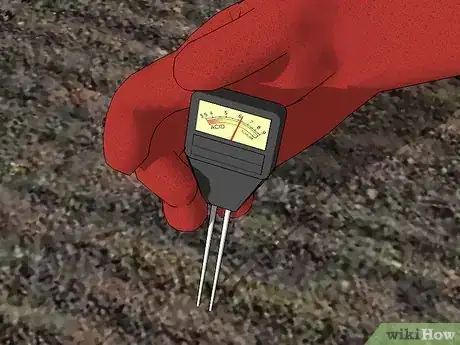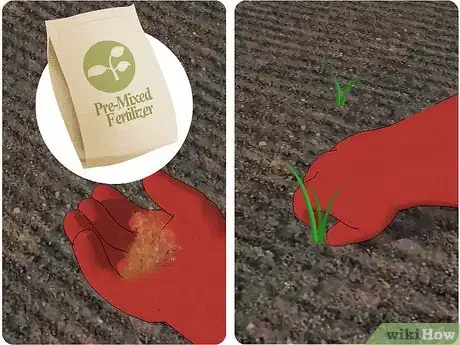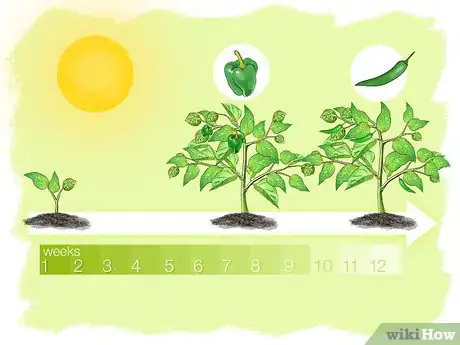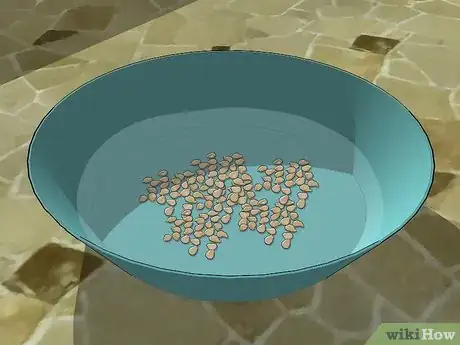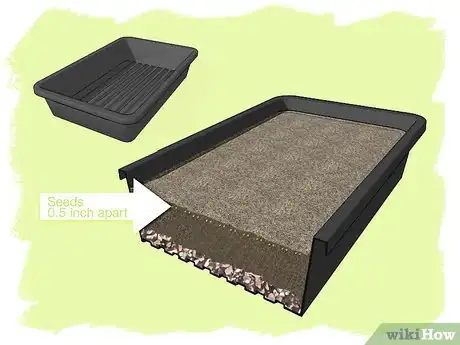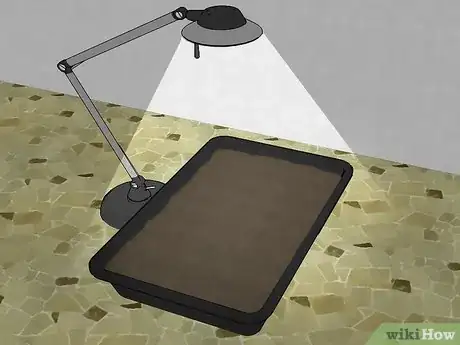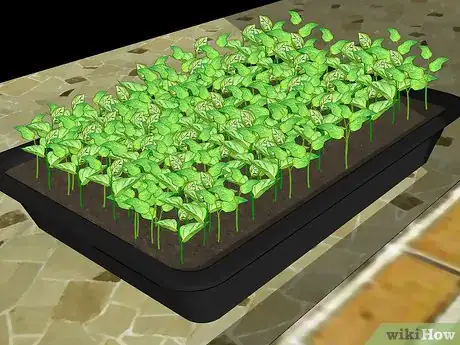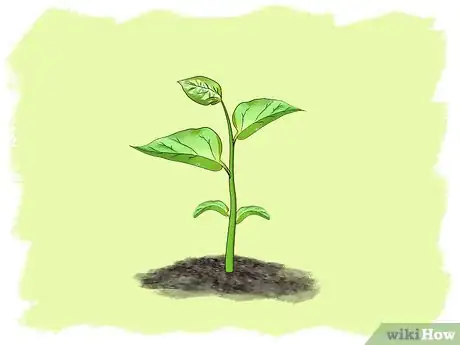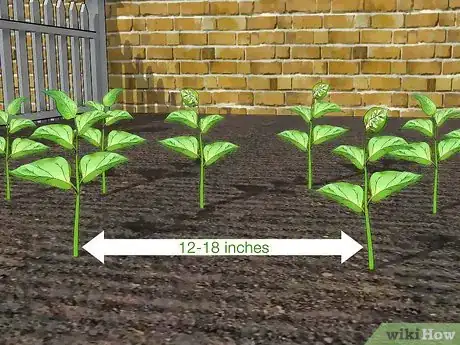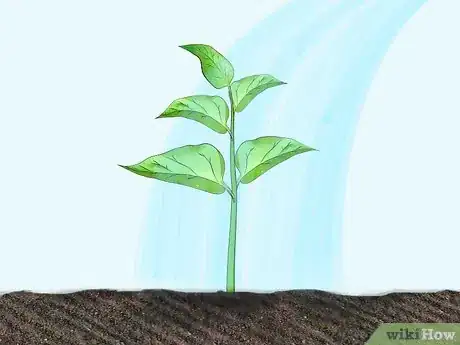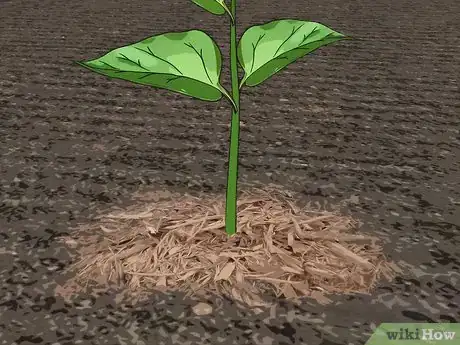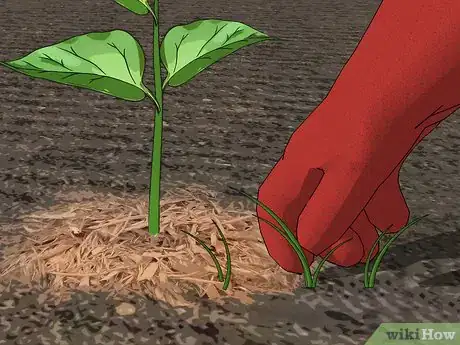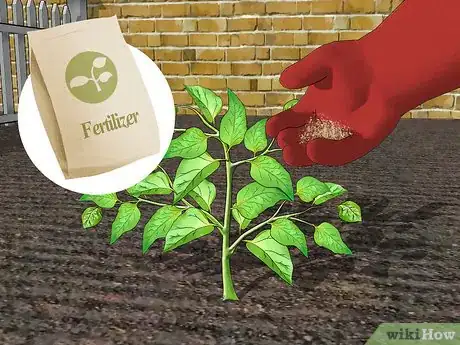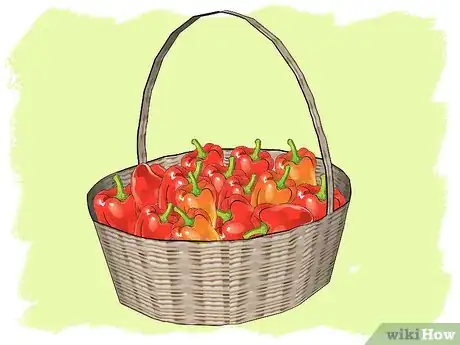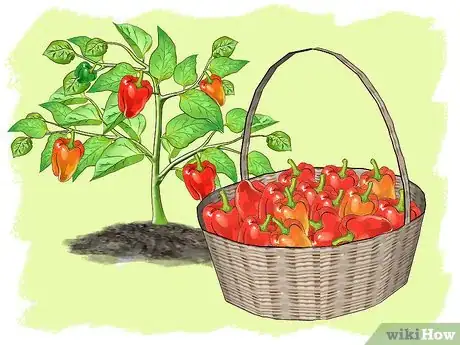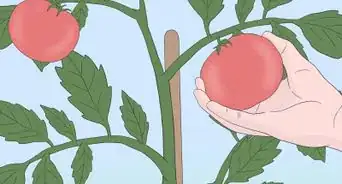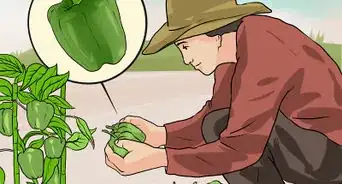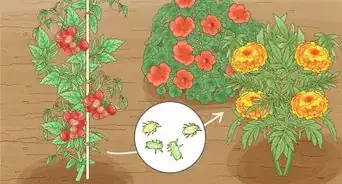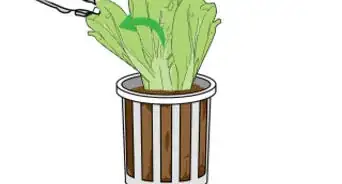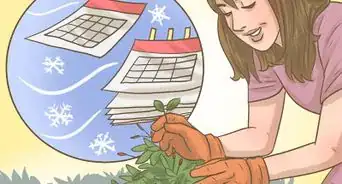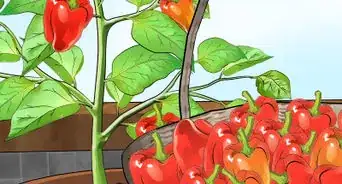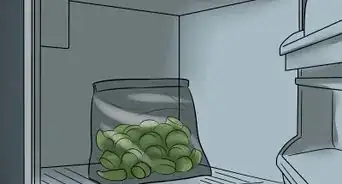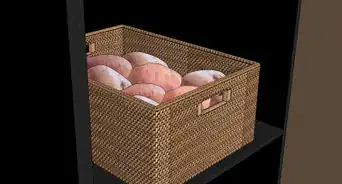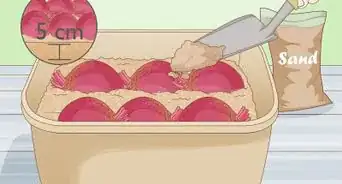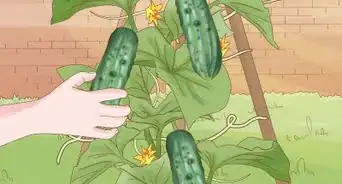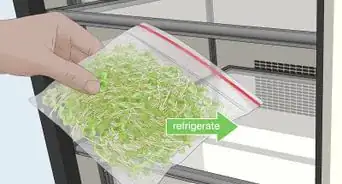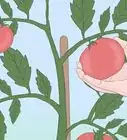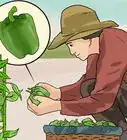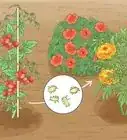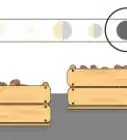This article was co-authored by Lauren Kurtz. Lauren Kurtz is a Naturalist and Horticultural Specialist. Lauren has worked for Aurora, Colorado managing the Water-Wise Garden at Aurora Municipal Center for the Water Conservation Department. She earned a BA in Environmental and Sustainability Studies from Western Michigan University in 2014.
This article has been viewed 39,201 times.
From crisp and sweet to small and spicy, there are countless varieties of peppers to choose from. Whether you choose to start your plants from seedlings or buy healthy transplants, you can grow peppers of all varieties in your own backyard! Follow the steps below to learn how to prep your garden, plant your peppers, and take care of them for years to come.
Steps
Preparing Your Garden
-
1Choose a variety of peppers. There are many types of peppers available on the market, and you can choose which kind to grow depending on the size, color, and level of spice your desire.
- Bell peppers, also called sweet peppers, are the most mild of all the pepper varieties. They come in shades of red, orange, yellow, and green and tend to be about the size of a fist. Grow these to eat raw or add to many dishes.
- Hot peppers come in many different varieties. The most mild of all the hot peppers is the anaheim pepper, but other popular varieties include the jalapeno and the serrano pepper.[1]
-
2Select a patch for your garden. Choose an area in your yard with full sunlight and good drainage.
- You will grow the largest peppers in full sunlight, but they can grow in a bed that has a little shade. Avoid planting peppers in an area in complete shade.
- If your soil is very rocky or tends to flood in the rain, consider using pots or building a raised bed for your peppers.
Advertisement -
3Test the pH of the soil if you want exact information on how well your peppers will grow. Peppers grow best in a soil with a pH between 6.2 and 7.0. Err on the high side of the pH scale, however, as peppers can withstand slightly alkaline conditions.
- This step isn’t mandatory, but could help you determine the most effective strategy for keeping your soil and plants healthy.
-
4Use soil amendments to keep your soil healthy for longer. While fertilizers affect the nutrients in the soil, amendments improve aspects of the soil’s physical condition, including its pH level. If your soil is typically acidic, consider working some lime into it a few months before planting, then conducting a second pH test to ensure you’re in the desired range. If your soil is too alkaline, use peat moss or garden sulfur.[2]
-
5Prepare your soil. Mix compost into your soil and remove any rocks and separate any large chunks in the dirt.
- Fertilizers include fishmeal, chicken manure, or a pre-mixed fertilizer available for purchase at a local gardening center.
- Hand pick any weeds that may be present to prevent them from overrunning your pepper patch.
Growing Your Peppers from Seeds
-
1Find the right time to grow. Different varieties of peppers take different amounts of time to grow, so check your pepper species to find out. Hot peppers take the longest - about 12 weeks until maturity - while bell peppers take about 8 weeks to reach maturity.
- Peppers don’t grow in cold or frosty soil, so wait to plant them until the weather has warmed enough.
- Plant peppers outside at least one month after your last day of frost for the best temperature of soil. You can look up the last frost date in your area on the Internet or in a farmers’ almanac
- Choose a date that you feel matches the temperature requirements of outdoor soil for you peppers, and count back 8-10 weeks from that date; this is when you will start your seedlings. Memorial day is typically a good time to plant peppers, meaning that you start your seeds in early March.
-
2Soak your seeds. Soaking your seeds can help to break down the seed covering and expedite the growing process of the peppers. Place the seeds in a cup of water and leave them for 2-8 hours, or until the sink to the bottom of the cup.
- Make a cup of weak chamomile tea to disinfect the seeds and break down the seed coats.
- Mix two tablespoons of hydrogen peroxide with a cup of lukewarm water to soak the seeds in if chamomile tea is unavailable.
-
3Sow your seeds in a seed tray. They will only stay in this tray until they’re ready to plant, so don’t worry about using anything too nice or fancy.
- Use a store-bought seed tray for the easiest place to sow your seeds, or make your own using an old plastic or cardboard milk jug with holes poked in the bottom.[3]
- Fill the bottom of the seed tray with pebbles or small rocks and then cover with potting soil.
- Plant seeds half an inch apart just under the surface of the soil, and water well.
-
4Use lights to help the seeds grow. Peppers need a lot of sunlight, but the seeds can’t get enough sun from a window indoors. Instead, use any large light (it doesn’t have to be hot) and place it as close to the seedlings as possible.
-
5Move your seedlings into new pots when they start growing leaves. Once each seedling has two pairs of true leaves, transplant them from their starter trays into 2-4 in. (5-10 cm) pots with potting soil. Keep the plants under light until they grow 4-6 in. (10-15 cm) tall.
- True leaves are the leaves you see on full-sized pepper plants, large and pointy, as opposed the the rounded cotyledons that sprout from the seedling first.
-
6Harden off your seedlings when they are 4-6 inches (10-15 cm) tall. Pepper plants are delicate and need to be gradually exposed to a colder outdoor environment before they are transplanted entirely.
- About two weeks before you plan to transfer your plants outdoors, you need to gradually expose the plants to the outdoor climate.
- Start by placing your seedlings outdoors for a few hours each day, in an area protected from direct sunlight and wind. Slowly extend the number of hours the plants stay outside as they continue to grow.
- Avoid leaving the peppers outside overnight until you’re almost done hardening them off.
-
7Prepare your seedlings to plant outdoors. When the peppers have grown at least 4-6 in (10-15 cm) tall, they are large enough to be planted outside.[4]
Planting Your Peppers
-
1Plant your peppers. Space each plant between 18–24 inches (45.7–61.0 cm) apart, and insert stakes to help the plant stand up if necessary.
- This is the same process if you grow your peppers from seeds or if you transplant a store-bought pepper plant.
- Plant the peppers as deep in the garden soil as they were in the pots.
- Space rows of peppers about 10–15 inches (25.4–38.1 cm) apart.[5]
-
2Water the plants regularly. The soil can be dry at times, but pepper plants will produce the largest, most succulent fruit when watered regularly. Give the plant enough water to moisten the soil down to the roots.
-
3Add mulch to the soil. This will add nutrients that help the peppers to grow, and help to block out some weeds from taking root immediately.
- Straw and grass clippings make great mulch for pepper plants.
- Add a layer about two inches thick to all of the soil between and around each pepper plant.
-
4Pull any weeds by hand. If weeds pop up through the mulch, pull them gently by hand to avoid damaging the roots of the pepper plants. Weeds compete with your plants for space and nutrients and therefore should be removed from the planting area.
-
5Fertilize your pepper plants if necessary. Slow growth or the appearance of pale leaves are indicators that your pepper plants need fertilizing. Choose a high nitrogen fertilizer such as fish emulsion or compost tea and spread an even coating over the planting area. Follow the directions on your fertilizer bottle, and water before you fertilize so you don’t get run-off fertilizer.
-
6Harvest your peppers! Usually, peppers take around two months to mature enough to be harvested. To encourage your pepper plant to keep producing early in the season, harvest your peppers just before peak ripeness.
- Later on in the season when your plant is nearing the end of the production season, however, you can allow them to mature a bit longer before harvesting. The richer the color, the riper the fruit.
- Cut the pepper at the top of the stem. Pulling on your peppers can damage the fragile stalks and roots.
- If you are expecting a frost, be sure to pick all of the fruit, even if it is a bit under-ripe. A frost will damage any leftover fruit.[6]
-
7Finished.
Community Q&A
-
QuestionMy poor Trinidad pepper plant is wilting, what can I do?
 NinoxTop AnswererPepper is very sensitive to humidity. Be sure that the soil is dry before watering the plant to avoid an excess of water.
NinoxTop AnswererPepper is very sensitive to humidity. Be sure that the soil is dry before watering the plant to avoid an excess of water. -
QuestionHow long does pepper take to produce fruit?
 NinoxTop AnswererUsually it takes 4 to 5 months for a plant to produce fruit, but it depends on the climate and the plant species.
NinoxTop AnswererUsually it takes 4 to 5 months for a plant to produce fruit, but it depends on the climate and the plant species. -
QuestionCan I plant peppers from the seed found inside the fruit?
 Community AnswerYes! I have tried this, and 70% of the seeds germinated. Plant them as soon as you open the pepper to retrieve the seeds.
Community AnswerYes! I have tried this, and 70% of the seeds germinated. Plant them as soon as you open the pepper to retrieve the seeds.
Warnings
- Hot temperatures over 90 °F (32 °C) can hurt your pepper plants. Plant your peppers in an area where other taller plants will shade them during the hottest time of the day if high temperatures are a possibility.⧼thumbs_response⧽
References
- ↑ http://www.sheknows.com/food-and-recipes/articles/805359/types-of-hot-peppers
- ↑ http://homeguides.sfgate.com/lime-good-bell-pepper-plants-51781.html
- ↑ http://www.countryliving.com/gardening/garden-ideas/a35510/unexpected-seedling-starters/
- ↑ https://davesgarden.com/guides/articles/view/2266/#b
- ↑ https://www.almanac.com/plant/bell-peppers
- ↑ https://www.goodhousekeeping.com/home/gardening/a20705612/growing-peppers/
About This Article
To grow peppers, choose a location that gets full sunlight and good soil drainage. Test the soil for a pH between 6.2 and 7.0 and amend the soil with lime or sulfur, if needed. Sow the pepper seeds in a seed tray and keep the tray indoors until your seedlings are 4 to 6 inches tall. Expose them to a few hours of sunlight each day so they can adjust, then plant the seedlings outside, spacing the rows 10 to 15 inches apart. Water your plants regularly until your peppers are ready to harvest! For more tips from our Horticulturist reviewer, including how to mulch and fertilize your peppers, read on!
